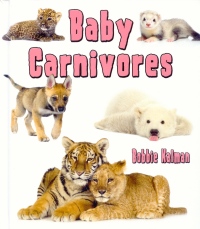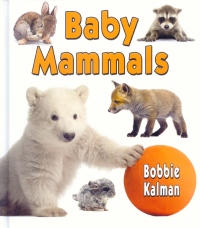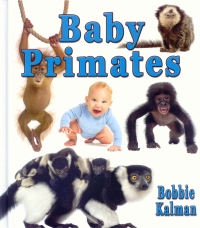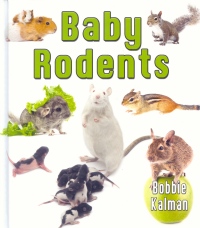| ________________
CM . . .
. Volume XIX Number 29. . . .March 29, 2013
excerpt:
Crabtree has added four new books to its “It’s Fun to Learn About Baby Animals” series: Baby Carnivores, Baby Mammals, Baby Primates and Baby Rodents. Like other books in the series, the information in these books is enhanced by many colourful photographs plus a few other illustrations. Text is large and clear black text on white background. Key words are printed in bold the first time the word is used in the text. Key words are also included at the back of the book in a section titled “Words to Know and Index”, but there is no meaning of the words. Usually but not always, the word is explained in the text. In Baby Carnivores, however, readers learn “[s]ea lions and seals are animals called pinnipeds. Sea lions have ear flaps, but seals do not (see page 23).” On page 23, we learn several interesting facts about seals and sea lions, but there is no explanation that pinnipeds are “fin-footed marine mammals” (en.wikipedia.org). “Words to Know and Index” is more a picture index. Photographs and illustrations with key words and page numbers help students locate specific information. For example, a picture of a kangaroo and joey in Baby Mammals is combined with the key words kangaroo (marsupials) and pages 7, 18. This should help young researchers find information about kangaroos, even though there is no explanation of the word marsupials. On page 18, students will learn some of the main characteristics of marsupials. Even then, students will have to deduce that marsupials are a group of mammals with certain characteristics. An opening sentence on this page to explain the meaning of the word marsupials would have added clarity for students who may never have heard this word before. One of the strengths of these books could also be considered one of its weaknesses. Several topics are repeated nearly verbatim in all four books. All four books include information on nursing babies with almost exactly the following words.
If you plan to use these books with small groups of students all researching the same topics, such as bodies, food, habitats, mothers, nursing, warm-blooded, you can use these four books as your information source and know that all of your students will be able to find the information for which they are looking. The question is whether the repetition of the information gives you the best value for your investment if you purchase all four books. A further concern that I have about these books is the stated belief that humans have superior intelligence compared to all other animals. In Baby Mammals, readers learn “[p]rimates are the smartest animals”, and “[h]umans are the smartest primates.” In Baby Primates, one of the questions in the “Match them up” quiz at the end of the book is: “Which is the smartest primate of all?” The answer is “D. human.” Although this may be a widely held belief, I worry that stating this opinion as fact contributes to an attitude of superiority that does more harm than good to our world. Three of the four books in this review have a type of picture table of contents to send students to different pages in the books for further information. Baby Carnivores has a double paged spread titled “Carnivora families”. Baby Mammals has a section called “Kinds of mammals” and Baby Primates has a section called “Kinds of primates”. Although Baby Rodents has a section called “Kinds of rodents”, it directs readers to pages 10 to 15 to learn about a few of the 2,000 kind of rodents, instead of specific pages for each animal group. All of the books have a traditional table of contents at the front of the book. Baby Carnivores deals only with mammal carnivores, members of the group called carnivore. Carnivorous reptiles, fish and birds are not included. The author does clarify this in her first chapter, “What is a carnivore?” Dog, cat, pinniped, weasel, bear, raccoon, and mongoose families are included. (Raccoons belong to the Procyonidae family, but like the author, I think I can leave that information out.) Baby Mammals includes babies with hoofs, elephant calves, rodent babies, rabbits, hares, and pikas, marsupial joeys, mammals with sharp teeth in the carnivore group, and smart primates. There is a good explanation of opposable thumbs. “An opposable thumb can touch the opposite fingers of the same hand. It allows primates to hold objects, such as tools, easily.” Baby Primates includes information about monkeys, apes, lemurs and others. It also has a chapter focusing on endangered primates. A quiz titled “Match them up” at the end of the book asks students five questions to “[t]est yourself to see how much you remember about the primates in this book. Match the pictures of these baby primates to the clues below.” All of the questions are recall, except for the question mentioned earlier in this review, “Which is the smartest primate of all?” The answer given is a picture of a very young girl using a computer. This information, that humans are the smartest primates, is actually found in one of the other books in the series, Baby Mammals. Baby Rodents gives a very brief overview of some of the large variety of rodents, including squirrels, porcupines, and several different rodents often kept as pets, such as gerbils, hamsters, guinea pigs and rats. The final page of the text shows pictures of four different animals and asks students to do some research to find out “Which ones do you think belong to rodent families?” Each picture is accompanied by a sentence explaining the similarity to rodents. For example, “Rabbits have four long front teeth that keep growing. Are they rodents?” The answer is given in upside down text in a box at the bottom of the page. “None of the animals shown here are rodents. Did you research what kinds of animals they are?” This is an interesting way to end this book because it may lead to some good questions if students are sufficiently motivated, and given enough time, to investigate rodents further. Although these books are not without weaknesses, the large, clear black on white text and beautiful photographs, may make these new books in the “It’s Fun to Learn About Baby Animals” useful additions to libraries looking for entry level research books on baby animals. Recommended. Suzanne Pierson, a retired teacher-librarian, currently instructs Librarianship courses at Queen’s University in Kingston, ON.
To comment
on this title or this review, send mail to cm@umanitoba.ca.
Copyright © the Manitoba Library Association. Reproduction for personal
use is permitted only if this copyright notice is maintained. Any
other reproduction is prohibited without permission.
NEXT REVIEW |
TABLE OF CONTENTS FOR THIS ISSUE
- March 29, 2013.
AUTHORS |
TITLES |
MEDIA REVIEWS |
PROFILES |
BACK ISSUES |
SEARCH |
CMARCHIVE |
HOME |



